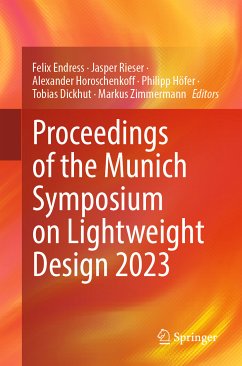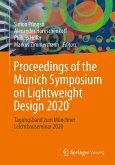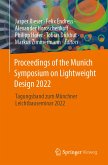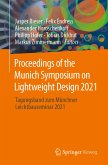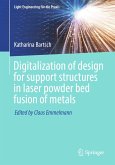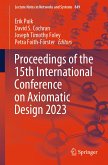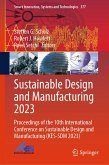Proceedings of the Munich Symposium on Lightweight Design 2023 (eBook, PDF)
Redaktion: Endress, Felix; Zimmermann, Markus; Dickhut, Tobias; Höfer, Philipp; Horoschenkoff, Alexander; Rieser, Jasper


Alle Infos zum eBook verschenken

Proceedings of the Munich Symposium on Lightweight Design 2023 (eBook, PDF)
Redaktion: Endress, Felix; Zimmermann, Markus; Dickhut, Tobias; Höfer, Philipp; Horoschenkoff, Alexander; Rieser, Jasper
- Format: PDF
- Merkliste
- Auf die Merkliste
- Bewerten Bewerten
- Teilen
- Produkt teilen
- Produkterinnerung
- Produkterinnerung

Hier können Sie sich einloggen

Bitte loggen Sie sich zunächst in Ihr Kundenkonto ein oder registrieren Sie sich bei bücher.de, um das eBook-Abo tolino select nutzen zu können.
This book includes topics like composite structures, SHM, microstructures, material modelling, design for additive manufacturing, numerical optimization and in particular topology optimization in aerospace, automotive, and other industries. Every year, the Technical University of Munich, the Universität der Bundeswehr München, and the University of Applied Sciences in Munich invite researchers and practitioners to join the Munich Symposium on Lightweight Design. Experts from industry and academia discuss design tools, applications, and new developments. The talks are summarized in short articles and presented in this volume.…mehr
- Geräte: PC
- ohne Kopierschutz
- eBook Hilfe
- Größe: 38.01MB
![Proceedings of the Munich Symposium on Lightweight Design 2020 (eBook, PDF) Proceedings of the Munich Symposium on Lightweight Design 2020 (eBook, PDF)]() Proceedings of the Munich Symposium on Lightweight Design 2020 (eBook, PDF)121,95 €
Proceedings of the Munich Symposium on Lightweight Design 2020 (eBook, PDF)121,95 €![Proceedings of the Munich Symposium on Lightweight Design 2022 (eBook, PDF) Proceedings of the Munich Symposium on Lightweight Design 2022 (eBook, PDF)]() Proceedings of the Munich Symposium on Lightweight Design 2022 (eBook, PDF)113,95 €
Proceedings of the Munich Symposium on Lightweight Design 2022 (eBook, PDF)113,95 €- -29%11
![Proceedings of the Munich Symposium on Lightweight Design 2021 (eBook, PDF) Proceedings of the Munich Symposium on Lightweight Design 2021 (eBook, PDF)]() Proceedings of the Munich Symposium on Lightweight Design 2021 (eBook, PDF)129,95 €
Proceedings of the Munich Symposium on Lightweight Design 2021 (eBook, PDF)129,95 € ![Digitalization of design for support structures in laser powder bed fusion of metals (eBook, PDF) Digitalization of design for support structures in laser powder bed fusion of metals (eBook, PDF)]() Katharina BartschDigitalization of design for support structures in laser powder bed fusion of metals (eBook, PDF)97,95 €
Katharina BartschDigitalization of design for support structures in laser powder bed fusion of metals (eBook, PDF)97,95 €![Innovations in Topology Optimization (eBook, PDF) Innovations in Topology Optimization (eBook, PDF)]() Nikolaos KladovasilakisInnovations in Topology Optimization (eBook, PDF)40,95 €
Nikolaos KladovasilakisInnovations in Topology Optimization (eBook, PDF)40,95 €![Proceedings of the 15th International Conference on Axiomatic Design 2023 (eBook, PDF) Proceedings of the 15th International Conference on Axiomatic Design 2023 (eBook, PDF)]() Proceedings of the 15th International Conference on Axiomatic Design 2023 (eBook, PDF)121,95 €
Proceedings of the 15th International Conference on Axiomatic Design 2023 (eBook, PDF)121,95 €![Sustainable Design and Manufacturing 2023 (eBook, PDF) Sustainable Design and Manufacturing 2023 (eBook, PDF)]() Sustainable Design and Manufacturing 2023 (eBook, PDF)186,95 €
Sustainable Design and Manufacturing 2023 (eBook, PDF)186,95 €-
-
-
Dieser Download kann aus rechtlichen Gründen nur mit Rechnungsadresse in A, B, BG, CY, CZ, D, DK, EW, E, FIN, F, GR, HR, H, IRL, I, LT, L, LR, M, NL, PL, P, R, S, SLO, SK ausgeliefert werden.
- Produktdetails
- Verlag: Springer International Publishing
- Seitenzahl: 170
- Erscheinungstermin: 26. Juli 2024
- Englisch
- ISBN-13: 9783031646690
- Artikelnr.: 71329913
- Verlag: Springer International Publishing
- Seitenzahl: 170
- Erscheinungstermin: 26. Juli 2024
- Englisch
- ISBN-13: 9783031646690
- Artikelnr.: 71329913
- Herstellerkennzeichnung Die Herstellerinformationen sind derzeit nicht verfügbar.
.- 2: Studies Concerning the Fiber Orientation in Thin Walled, Injection-Molded PP Plaques.
.- 3: A new concept of collector-ply layer and multilayer design for lightweight CFRP liquid hydrogen tanks.
.- 4: Identifying Optimization Potential of a Centrifugal Pump.
.- 5: Effect of water absorption on the clamp load of plastic nuts.
.- 6: Simulation based determination of the mechanical properties of fiber-matrix composite materials taking production-related scattering into account.
.- 7: Influence of manufacturing dependent mechanical properties on the optimization of ribbed LFT structures.
.- 8: Braiding of Wooden Veneer Strips - Correlation of Process Parameters and Laminate Properties.
.- 9: Design optimization of aircraft cabin panels by additive manufacturing.
.- 10: Metal Foam in Lightweight Heat-Exchangers: Innovation and Recycling Imperatives.
.- 11: Prediction of the Bending Collapse of Thin-walled Rectangular Tubes.
.- 12: Hybridization of reinforcing nonwoven structures made.
.- 13: A Method for the Selective Reinforcement.
.- 14: Analytical and Numerical Modeling of Aramid Honeycomb Cores.
.- 2: Studies Concerning the Fiber Orientation in Thin Walled, Injection-Molded PP Plaques.
.- 3: A new concept of collector-ply layer and multilayer design for lightweight CFRP liquid hydrogen tanks.
.- 4: Identifying Optimization Potential of a Centrifugal Pump.
.- 5: Effect of water absorption on the clamp load of plastic nuts.
.- 6: Simulation based determination of the mechanical properties of fiber-matrix composite materials taking production-related scattering into account.
.- 7: Influence of manufacturing dependent mechanical properties on the optimization of ribbed LFT structures.
.- 8: Braiding of Wooden Veneer Strips - Correlation of Process Parameters and Laminate Properties.
.- 9: Design optimization of aircraft cabin panels by additive manufacturing.
.- 10: Metal Foam in Lightweight Heat-Exchangers: Innovation and Recycling Imperatives.
.- 11: Prediction of the Bending Collapse of Thin-walled Rectangular Tubes.
.- 12: Hybridization of reinforcing nonwoven structures made.
.- 13: A Method for the Selective Reinforcement.
.- 14: Analytical and Numerical Modeling of Aramid Honeycomb Cores.
